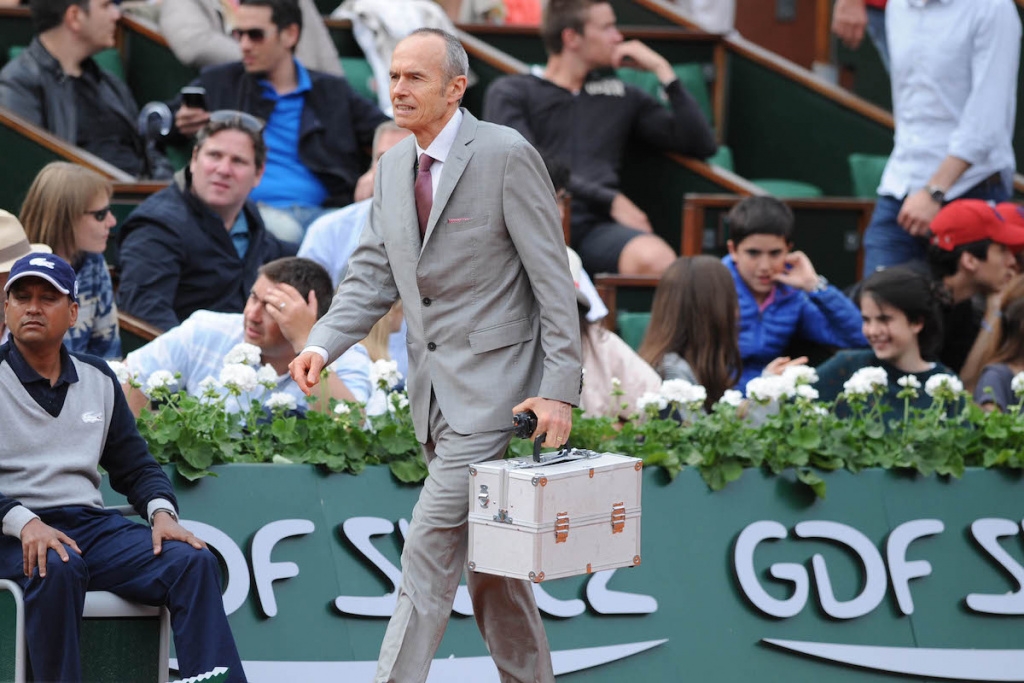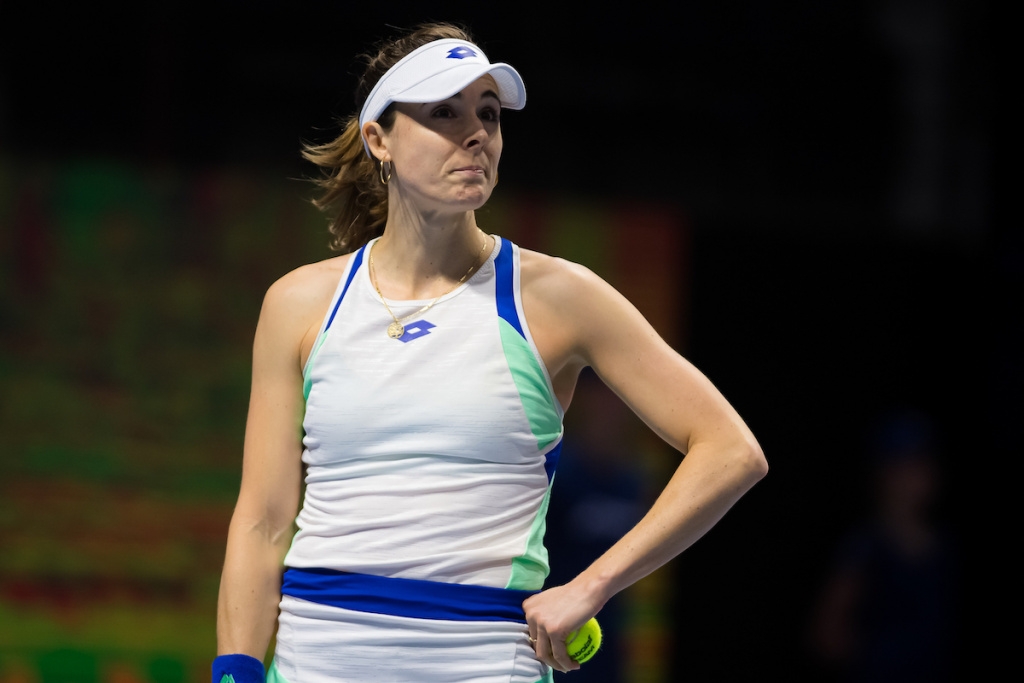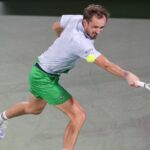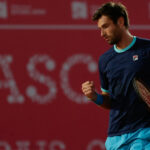Getting back on court, sure, but how and for what?
As many players have spent two months or more without being able to train, it’s not that easy for them to get back intensively on the court. They all had to adjust. And some more adjustments are going to be needed to get back to competing.
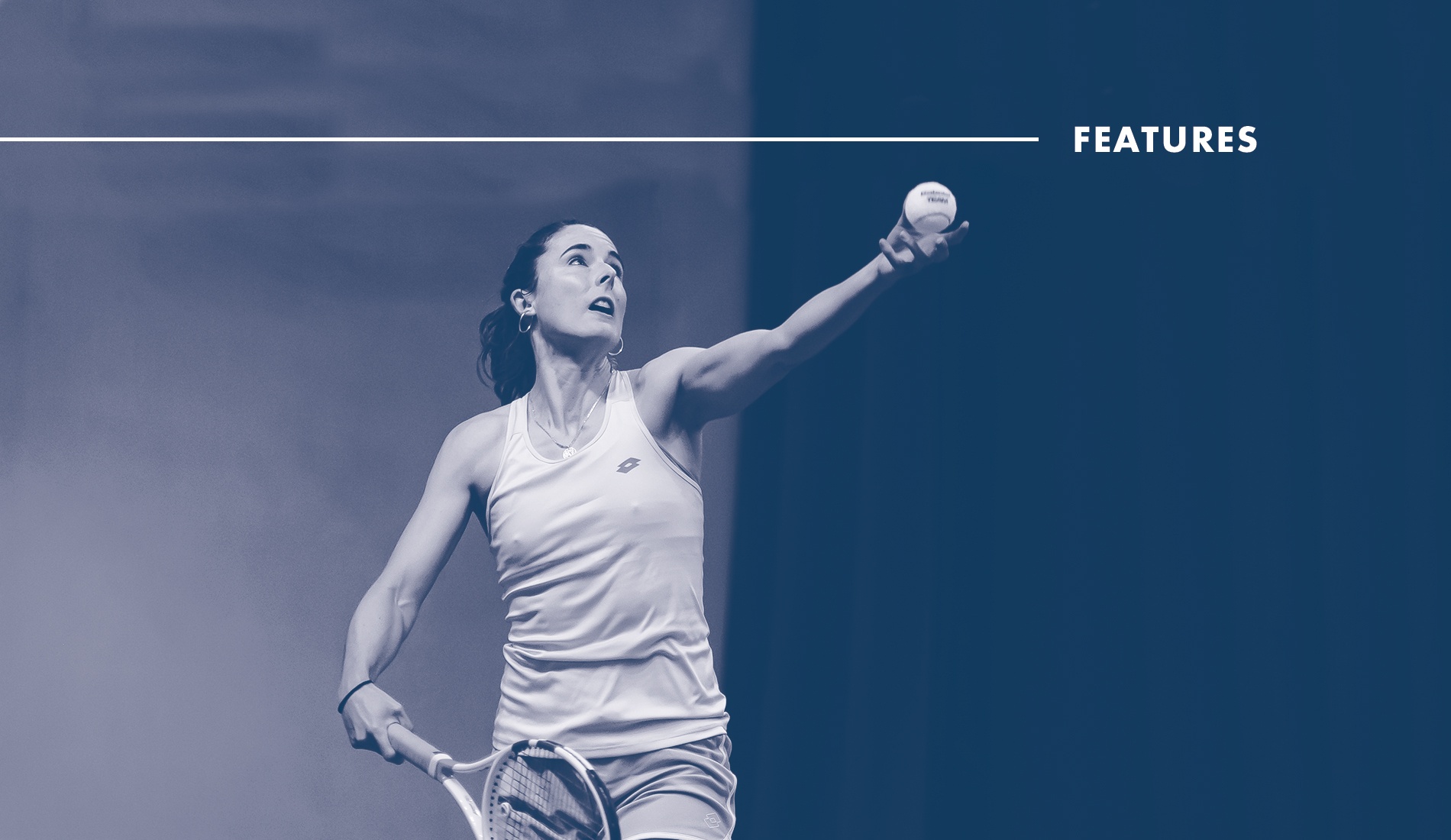 Alizé Cornet – WTA
Alizé Cornet – WTA
Alizé Cornet (ranked No 59) and the French doctor Bernard Montalvan, associate director in charge of everything medical at the French federation, are our guides through all of those questions.
Not everybody was lucky enough to have a tennis court available to keep hitting during the lockdown. Not everybody had the desire to try to find one. Also, between a 20-year-old player and a 35-year-old one, time spent without being able to train doesn’t have the same consequences. So when professional players were allowed to train again at Roland-Garros on outside courts and indoors at the national training centre, a specific sanitary process was put in place before even a single player was to go through the entry door. Dr Montalvan tells us all about it.
“We asked the players figuring on our high-level lists to get through a medical check-up. Firstly in order to get in touch with them again and see how they were doing, how their lockdown had gone, if they had been sick, and also to answer their questions. Then they had the check-up to see if there was any reason to suspect Covid-19 cases. Then players had a resting electrocardiogram because you might find heart signs warnings when one gets back to professional sport. If we were suspecting a Covid-19 case, players were receiving biological tests and echocardiography. One player here did an MRI. And if nothing was found, we anyway asked them to be tested: a blood test or an igM/igG rapid test validated by the regional agency. Nearly everyone did it.”
“We decided very early to be guided by a college of medical experts”
Roland-Garros and the CNE being in Paris, a city that was still deemed a red zone when players were allowed to resume training, the FFT couldn’t take any risks. And as the French federation will launch a series of national tournaments in July, before hosting the last Major of this so special 2020 season, it also helps them get their sanitary process ready. Like some national governments, the FFT also put together a scientific council, as Dr Montalvan explains.
“We decided very early to be guided by a college of medical experts: an infection expert, a hygiene expert, a sociologist, a data specialist, and a few psychologists. They’re helping to decide on what we can or cannot do. We’re trying to have science with us, still acknowledging that it’s very difficult because advice can change one day to another. It’s tough to have scientific certainty in such anxiety-inducing circumstances. We’re relying a lot on that college of experts which whom we have weekly talks, and then we’re setting our guidelines so players are able to get back to tennis while avoiding to spread the virus as much as possible. We’ve put all the information on the FFT website.”
Everybody is careful; all the coaches wear masks
Cornet is based in the south of France, so she got back to practice at the Mouratoglou Academy. She’s also noticing some changes in her days of training but actually not that much. And she was starting to feel a bit restless without being able to play. “It started to be tough around after seven or eight weeks.” So the joy of resuming training took over the adjustment to new safety measures. “We’re having temperature screening every day when we arrive, but there’s no more testing than that. Everybody is very careful: all the coaches wear masks, the fitness room is only dedicated to professional players. For now, it seems everything is fine. We’re all getting used to this and it’s nothing insurmountable.”
As she now can train again, the main thing is to get back to the desired level of play in order to be ready for when the Tour resumes. Cornet couldn’t train more than a couple of times during the lockdown, despite trying to hit on the wall of her garage. But her neighbours weren’t having any of it. “They got mad at me because it was making too much noise so it wasn’t ideal (she laughs).” So she waited, did her fitness work, and then ran to the academy as soon as the doors were opening again.
“I started to train again when the Academy opened, so around three or four weeks ago. I’m hitting three or four times per week: not every day because I don’t want to get burnt out for the rest of the season, as we still don’t really know where we’re going to go. I’m trying to stay fresh. It went well, sensations were a bit tough to come back at first but they still came back pretty fast. Physically, it was fine but now I’m starting to have a bit of pain in my shoulder, yet I think it’s because the body needs time to get used to training intensity again. With what tennis inflicts to the upper body, it’s a bit complicated when you haven’t been hitting for two months. In a month or so, it should get much better.”
Every player is different
But those players really have tennis ingrained in their DNA, so Cornet didn’t struggle for too long before getting her feelings back. After two decades spent hitting tennis balls, some things never go away. But even when the body is fit and when the hand still knows what to do with the racquet, some fine-tuning remains.
“I hit like twice during the lockdown, so it wasn’t much at all. But getting back to it wasn’t so weird after all, I felt like sensations were good. It’s just a bit tough in terms of vision: I was always a bit too late and I felt I wasn’t seeing the ball as well as usual. But again, it came back quickly. I really found a way to work on my fitness during the lockdown so it helped me, and I never felt like a seal when back on court (she laughs). I felt good in my footwork, quick and swift, so it reassured me and it allowed me to really go back into training in the best conditions.”
And that’s one of the keys for those players now getting back into training: taking care of their body. Montalvan warns that not all players got out of lockdown in the same shape, so there are consequences. “You have three types of players: the player who doesn’t miss tennis that much; the player who needs to hit a lot and so found a way to get a house with a tennis court to play with friends or family and so played regularly; then you have the older players, the 35 years old, for whom it’s more difficult to get back to work after a long break, even if they’ve been to the gym.”
To avoid any issues, Cornet pushed herself to keep the discipline of the fitness work. At first, it wasn’t easy but she turned the negative into positive energy. “I’m not going to lie, it wasn’t easy every day but at the same time, it really helped me in the end. I kept telling myself that resuming to play would be much easier if I could stay fit. And little by little it became a pleasure! I was doing my hour or an hour and a half of fitness in the garage every day: it became like a special “me” time.”
Having a good team is extremely important for the players these days, as mistakes during the resumption of training could mean failure through the end of the season. Cornet and her team decided to be extra cautious.
“My physio is helping me a lot. We did talk about it through the lockdown and he told me we’d really need to be cautious when back to training, that we’d have to keep an eye on the joints and on everything that is put to work by tennis. We couldn’t avoid everything as my shoulder is a bit painful now, but overall I think we did a good job. We also resumed specific work with my fitness coach. I really have a good team and they’ve put me right back on track. My coach isn’t there though, she’s still in Poland so I train with sparring partners, my boyfriend, or friends. I’m on my own a bit but it’s all good.”
One positive case
Dr Montalvan found only one positive case for Covid-19 among the players tested. “Many told us they did have it at some point, but we only found one case!”, he laughs. “And he’s fine, but we still put him through all the check-ups. It’s all normal, we’re in a special time where we’re listening to our sensations a lot so if there’s a chill or some sore throat…” if everybody was ready to go when training resumed, the goal is, of course, to go on like this. A few cases in a world like tennis that lives in a bubble, and you could easily get a cluster. A cluster with teams and families, and which wants to travel the Tour. A cluster that could, if the worst came to the worst, send players into quarantine and force stadiums to close. Unthinkable, so Roland-Garros is enforcing specific rules, as Dr Montalvan told us.
“Mask is mandatory off the court because players are going to cross path with coaches, other people, physio, the staff of the FFT. As soon as they move away from the courts, they have to put the mask on. Physios are tested, coaches too, same for the fitness trainers. We’re testing the whole entourage if they agree of course. For the treatments, we take 10 minutes between each player to open the windows and clean, and masks are mandatory. And of course, we have hand sanitizer. Masks, physical distancing, glasses: those are the best way to avoid the virus. One can also be asymptomatic. That virus is always brought by someone. Our goal is to protect everybody and in the end, it relies on obvious things but we weren’t noticing them enough before.”
An obvious process, but the doctor isn’t in denial: he knows players are going to struggle to stick to rules that are so foreign compared to their usual habits on Tour.
“It’s going to be tough because of how the life of a tennis player is shaped: they’re together in the lockers all the time, they’re nomads… They move in a pack, they’re always in touch with one another. At Roland-Garros we know for example that if one player gets diarrhoea, 25 will then get it too. Our job is to give them information about the rules to respect. It’s difficult because people come to tennis to have fun, and those days we all need some. But at the same time, all those rules must be followed. They’re young, a bit restless and we know it but for now, I’ve found the players very calm about all of this. A tennis player is coming of age pretty early: they know the dangers, are very responsible, and have great teams.”
We’re just at the start of the resumption of training, and we can see it’s tough to really be sure of how the situation will evolve. The rules can change from a country to another, from an event to another. But the players need to be able to keep working in conditions as close to what they’re used to as possible or injuries will come. That’s why, actually, time is counted a bit with that summer Tour in France and then the resuming of the Tour, with the US Open kept in the schedule by the USTA and the governor of New York (August 31st – September 13rd).
US Open: “Nothing is clear, I don’t feel very confident about it”
Cornet is a perfect example of what’s at stake for many players now: going or not going… The French player hesitates. “At this stage of my career, even if I love the game, I’m not playing to just play but to compete. That’s the main goal after two decades in this sport. I can’t wait for the Tour to resume, to get finally a goal, and more motivation.” The events set up in France in July are a first step, but it’s of course about the US Tour that Cornet doubts the most.
“Nothing is clear, I don’t feel very confident about it. I was so very motivated to resume the competition in the US, to see that we were going to get back for the US Open, thinking about the points and the prize money. But when I see how it’s going, I’m getting less and less excited about it. I wonder if it wouldn’t be better to wait for the Tour to get back to Europe and play with good conditions, even if it means not playing a Grand Slam event. I’m starting to change my mind. I’m so impatient to play again, so I’m ready to travel on my own if needed: nothing will stop me! As for the health concerns, I’m really not worried because they’re really serious about it over there. I just have the feeling that we’re pushed into it… Maybe it comes from the way the WTA is presenting it to us, but I really feel it’s very complicated. Playing without crowds, alone on the court, without coach, nothing: I don’t care, I just want to play! (she laughs) But now they’re talking about testing us every three days, it’s insane… I don’t know if it’s worth it.”
At Roland-Garros, they’re in the middle of the thought-process about testing the players. No decision has been taken, says Dr Montalvan. “We’re currently asking our college of experts about it. We’re in touch with the US Open, with their medical staff: we need to be consistent about all of this. We’re still wondering what’s best. It’s tough but safety is important when it’s set up in stability. We need to have clear guidelines, scientifically motivated.”
Science won’t be the only tool for the players when decision time will come: there will also be the need or not to get some money. Cornet doesn’t shy away from the topic: of course, the prize money of the US Open is a motivation for the players.
“Sure, but in the end, it’s always the same thing: the top 10 players don’t need it. I have the feeling that they’re all a bit against it and prefer to get back to the Tour in good condition. But we need to think to all the players who are struggling right now and who need that money. It’s a bit of a double standard and I’m not sure where the pointer should be put. But we’re in a crisis so we need to think of those who are in trouble.”
Another thing could make the players hesitate: the risks taken for their bodies. “That’s what is also rough for me“, admits Cornet. “We have Madrid to play (12-20 September) the week after the US Open. I really feel like we’re sacrificed.”
Between getting back to training and getting back to competition, there’s a whole unknown world. And players, staff and medical experts will surely discover things on the go. So many decisions remain to be taken by each individual about what risk to take or not…
